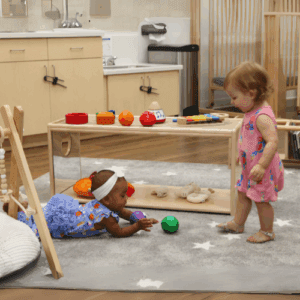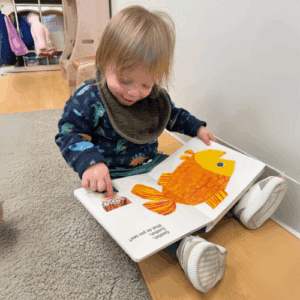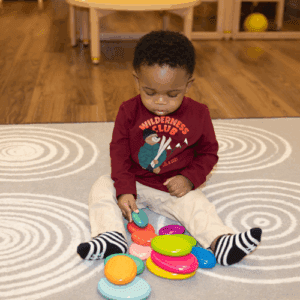As parents and caregivers, we know that raising a toddler is an adventure filled with joyful discoveries, emotional highs, and—sometimes—unpredictable clinginess. One moment, your child is confidently exploring their world, and the next, they refuse to let go of your leg. If you’re wondering why your independent little one is suddenly glued to your side, you’re not alone. Clinginess in toddlers is a natural phase, often tied to important developmental milestones, emotional shifts, and life changes.
By understanding why this happens and how to support your child through it, we can help them build independence and security in a way that feels right for their age and stage.
Quick Answer: Why Is Your Toddler Suddenly So Clingy?
If your toddler has become extra clingy all of a sudden, there’s likely a good reason behind it. Often, it’s tied to developmental changes—such as grasping the idea of object permanence—which can make separations feel more intense. Big transitions like starting daycare, moving, or even a shift in daily routines can also leave them feeling uncertain, leading to increased neediness. Clinginess can also be a way of seeking comfort when a child is overwhelmed, overstimulated, or experiencing separation anxiety. While it can be challenging, remember that this phase is temporary and usually a sign that your child feels safe enough with you to express their needs.
Understanding Toddler Clinginess
Clingy behavior often shows up as toddlers become more aware of their world. Around 8 to 14 months, babies start to understand that people and objects still exist even when they can’t see them—this is called object permanence. While this is a huge cognitive milestone, it also means your child now realizes that when you leave, you aren’t just disappearing—you’re somewhere else, and that can feel unsettling.
This newfound awareness can lead to separation anxiety, which is why some toddlers struggle with goodbyes, even in familiar settings. The intensity of this anxiety can ebb and flow depending on your child’s temperament, experiences, and external factors.
Clinginess isn’t just about fear of separation, though. It can also be a way for toddlers to seek reassurance as they process changes in their world. Whether it’s teething pain, a new sibling, or a shift in routine, a toddler may become clingier as they work through their emotions and look to you for comfort and stability.
Common Triggers for Increased Clinginess
Understanding what sparks clinginess can make it easier to respond with patience and reassurance. Here are a few common reasons a once-independent toddler may suddenly become extra attached:
- Changes in Environment: Moving to a new home, starting daycare, or even having a new caregiver can leave a toddler feeling uncertain and seeking the familiarity of their primary caregiver.
- Disruptions in Routine: Young children thrive on predictability. If naptimes, bedtimes, or mealtimes shift unexpectedly, it can create stress, making them more likely to cling to what feels familiar—you.
- Big Emotions & Overstimulation: Sometimes, the world can just be a lot. Loud environments, unfamiliar places, or too many transitions in one day can overwhelm a toddler’s senses, leading them to seek extra closeness for comfort.
- Illness or Fatigue: When toddlers aren’t feeling well, they often become more dependent on their caregivers. Even minor discomforts like teething pain can make them extra needy.
Recognizing these triggers can help us respond in ways that make our toddlers feel secure while gently encouraging their growing independence.
Effective Strategies to Manage Clinginess
Clingy phases can test your patience, but they’re also an opportunity to help your child build confidence and emotional resilience. Here are some ways to support them through it:
1. Offer Reassurance Without Overreacting
Your toddler’s clinginess isn’t manipulation—it’s a request for security. Acknowledge their feelings with warmth: “I know it’s hard when I leave, but I’ll always come back.” Small moments of reassurance can go a long way, but avoid over-explaining or lingering too long on goodbyes, as this can make separations harder.
2. Keep Routines Predictable
A consistent daily rhythm gives toddlers a sense of stability. Regular wake-up times, meals, play, and sleep routines help them anticipate what’s next, making transitions—like saying goodbye at daycare—easier to handle. If something unavoidable disrupts their routine, prepare them in advance with simple explanations: “Tomorrow we’re visiting Grandma, so naptime will be later.”
3. Encourage Small Steps Toward Independence
Give your toddler chances to practice being on their own in a safe and playful way. Independent play, even for just a few minutes, builds confidence. Start by staying in the same room while they play, then step away briefly and return with a smile: “Look at you playing all by yourself! I love seeing what you’re building.”
4. Introduce Gradual Separations
If your child struggles with separation, practice leaving for short periods and returning as promised. Say goodbye in a calm, upbeat tone and avoid sneaking away, which can erode trust. A quick and loving farewell works best: “I love you! I’ll see you after snack time.”
5. Fill Their Emotional Cup
Clinginess often decreases when children feel securely connected. Make time for focused, one-on-one interactions—reading a book together, singing a favorite song, or simply giving them your full attention for a few minutes can help them feel more secure and less dependent on constant physical closeness.
When to Seek Professional Help
While clinginess is a normal stage, there are times when it might signal something more. If your toddler’s need for constant closeness is intense and doesn’t seem to improve over time, it’s worth taking a closer look.
Signs to Watch For:
- Their clinginess is interfering with daily life—if they refuse to engage in activities they once enjoyed or can’t handle brief separations, even with familiar caregivers.
- They show excessive distress that doesn’t ease with reassurance or practice.
- Their fear of separation is extreme, leading to full-blown panic or regression in skills like sleeping through the night or using the potty.
If any of these signs sound familiar, speaking with a pediatrician or child development specialist can help determine whether your child might need extra support. There’s no shame in seeking guidance—it’s simply another way of ensuring your little one gets the care they need to feel safe and grow confidently.
Supporting Your Toddler Through the Phase
When a toddler clings to us like a shadow, it’s easy to feel frustrated or even guilty—wondering if we’re handling things the “right” way. But the truth is, clinginess isn’t a sign of failure. It’s a sign that your child trusts you enough to show their most vulnerable feelings. With patience and a few key strategies, we can help them move through this phase with confidence.
1. Validate Their Feelings Without Dwelling on Them
It’s tempting to say, “You’re fine!” when your child clings at drop-off, but from their perspective, they don’t feel fine. Instead, acknowledge their emotions: “I see that it’s hard to say goodbye. I love you, and I’ll be back after lunch.” Then follow through on that promise.
2. Model Calm, Confident Goodbyes
If we look anxious or hesitate too long, our toddlers will pick up on it. A brief, loving farewell—without sneaking away—helps them learn that separations aren’t permanent or scary.
3. Work with Other Caregivers
If your toddler struggles with clinginess at daycare or with a babysitter, communicate openly with caregivers about routines and transition strategies. A familiar goodbye ritual, like a special wave or phrase, can make all the difference.
4. Keep Perspective
Like spitting, tantrums, or biting, this phase won’t last forever. One day, your little one will walk into a room without looking back—maybe even a little too quickly. For now, they just need reassurance that you’ll always be there when they need you.
Final Thoughts on Toddler Clinginess
Toddler clinginess is a normal and temporary part of development. While it can be exhausting, it’s also a sign of a strong, healthy bond between you and your child. By providing reassurance, maintaining routines, and gradually encouraging independence, we can help our little ones feel safe as they explore the world.
If clinginess becomes extreme or doesn’t improve over time, it’s always okay to seek guidance from a professional. But for most children, this phase will naturally ease as they grow and gain confidence. In the meantime, take a deep breath—you’re doing a great job.




